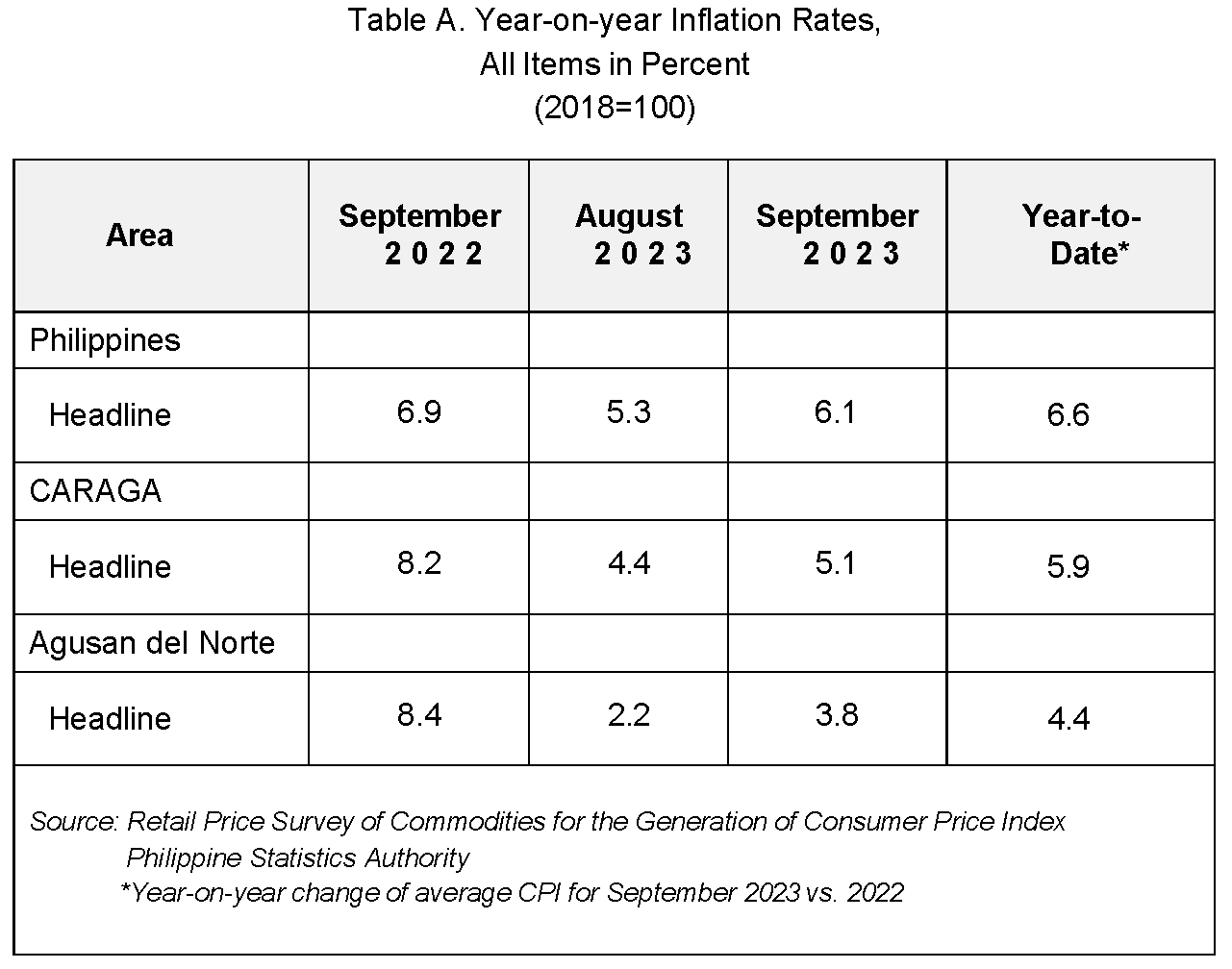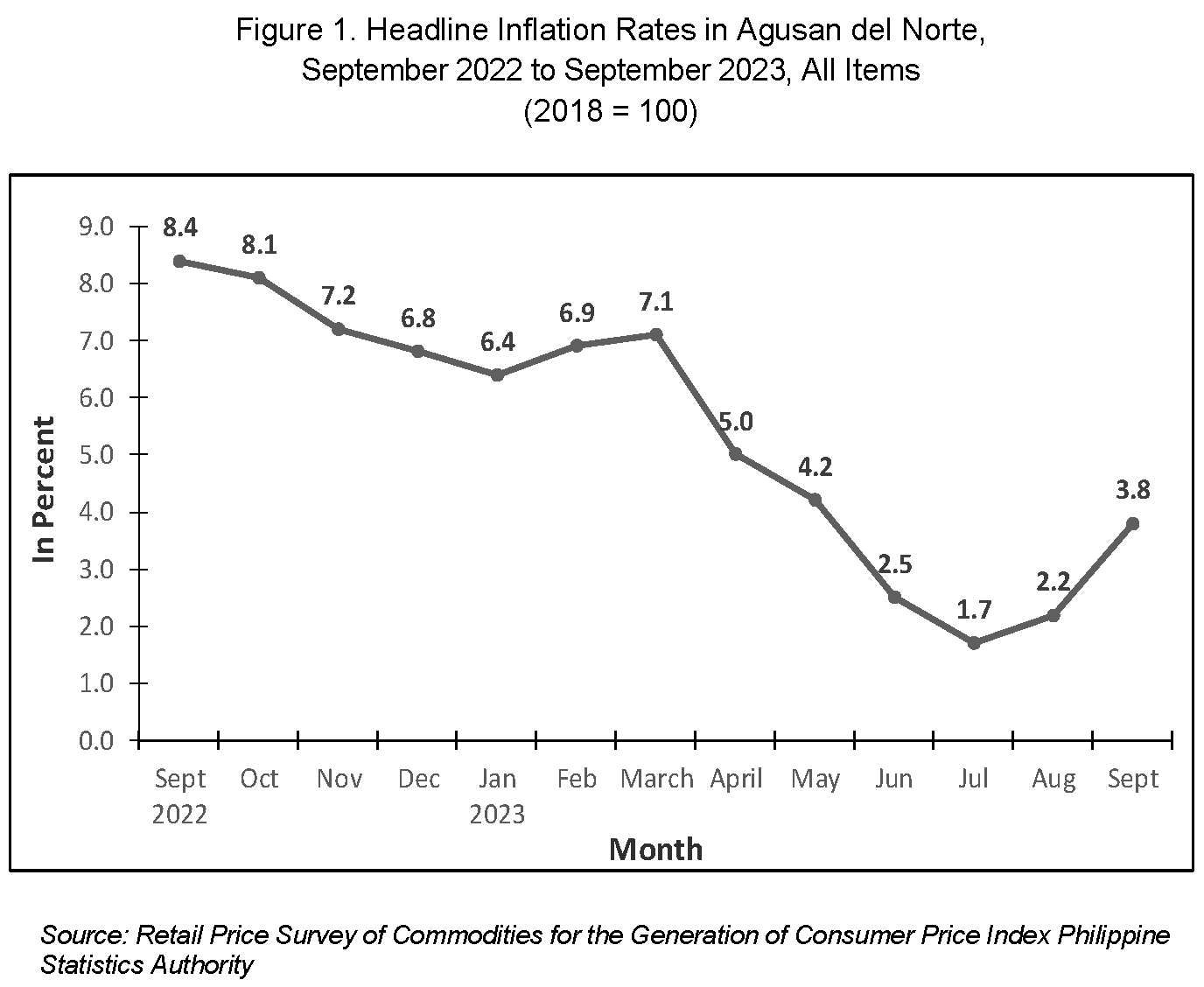Summary Inflation Report Consumer Price Index (CPI) (2018=100) Agusan del Norte
September 2023


The headline inflation rate of Agusan del Norte reached 3.8 percent in September of the year 2023.
In September 2023, the yearly headline inflation rate in Agusan del Norte rose to 3.8 percent from August's recorded rate of 2.2 percent. This increase marks a significant surge of 1.6 percent compared to the previous month and a notable decrease of 4.6 percent when compared to the inflation rate recorded in September of the previous year, which was at an elevated level of 8.4 percent.
The primary commodity groups that have contributed to the surge in inflation are as follows:
- Food and Non-Alcoholic Beverages, which have increased by 7.2 percent from last month's 3.7 percent and account for a significant 88.4 percent share of the inflation uptrend;
- Transport has only seen a minimal increase of 0.1 percent from (1.7) percent, but still contributes to the inflation uptrend with a noteworthy share of 9.0 percent;
- Restaurants and Accommodation Services have risen by 3.6 percent from their previous rate of 3.1 percent, contributing a 1.6 percentage to the overall inflation uptrend;
- Furnishings, Household Equipment and Routine Household Maintenance has seen an increase of about 1.5 percent compared to last month's value of 1.2 percent;
- Education Services is also on an upward trend with an increase from zero-percent recorded previously now standing at roughly half-a-percentage-point higher at 0.5 percent this time around; finally,
- Recreation, Sport and Culture saw gains as well increasing slightly by 0.1 percent, reaching it’s currently reported rise rate of around one-percent when compared against its prior monthly figure which stood at 0.9 percent.

In contrast, certain other commodity groups have experienced a deceleration in inflation this month. Specifically:
Alcoholic Beverages and Tobacco observed a decline from 8.7 percent to 7.2 percent since August of 2023;
Clothing and Footwear underwent only a slight decrease from 2.1 percent to 2.0 percent over the same period;
Housing, Water, Electricity, Gas and Other Fuels at (1.7) percent from (0.6) percent;
Health recorded a decrease from (1.2) percent to (0.8) percent;
Information and Communication registered a drop from 0.3 percent to (0.2) percent; and finally,
Personal Care, and Miscellaneous Goods and Services evidenced a significant reduction in inflation rates declining from 5.3% in August of 2023 down to just about half at only 4 .3%.
However, Financial Services commodity group remained at zero growth during this month. (See Attachment: Statistical Table 3)
Food Alone Inflation
The province's food inflation rate escalated from 3.8 percent in August 2023 to 7.5 percent this month, indicating a surge of 3.7 percent since the prior period. However, it is noteworthy that the current year-on-year inflation rate of 7.5 percent marks a deceleration by 2.8 percentage points compared to last year's corresponding figure of 10.3 percent.(See Attachment: Statistical Table 6-7)
The primary activators for the ascending inflation of Food Categories are as follows:
- Rice, which rose from 4.7 percent in the prior month to 20.5 percent;
- Corn, which increased slightly from 19.3 percent to 19.6 percent;
Meat and other parts of slaughtered land animals increased marginally from (0.9) percent to (0.4) percent; - Fish and other Seafood experienced a rise of 2.0 percent compared to the previous level of 1.7 percent; and
- Fruits and nuts witnessed an increase, from (20.6) percent to (12.8) percent.

TECHNICAL NOTES
The Philippine Statistics Authority generates and announces the monthly Consumer Price Index (CPI) based on the nationwide survey of prices for a given basket of goods and services. Two important indicators, the inflation rate and purchasing power of the peso (PPP), are derived from the CPI which are important in monitoring price stability and the value of the country’s currency.
The Consumer Price Index (CPI) is an indicator of the change in the average retail prices of a fixed basket of goods and services commonly purchased by households relative to a base year. It shows how much on the average, prices of goods and services have increased or decreased from a particular reference period known as base year.
Inflation Rate refers to the rate of change in the average prices of goods and services typically purchased by consumers. It is interpreted in terms of declining purchasing power of money.
Disinflation refers to a situation where the general level of prices is increasing but at a decreasing rate.
Deflation refers to a situation where the general level of prices is falling and the rate is below zero percent.
The Purchasing Power of the Peso (PPP) indicates the value of the peso in the period under review as compared to the value of the peso in the base period. It is computed as the reciprocal of the CPI for the period under review multiplied by 100.
Statistical Table refers to the statistical data presenting a reference table for the CPI, and Inflation Rate of each commodity groups and food items that are used for attachments.
Approved by:
(Sgd)REYNELO S. MAGNO
Chief Statistical Specialist, PSO – Agusan del Norte
Telephone number: (085) 817-3193 / Telefax No.: (085) 225 – 2097 Email address: agusandelnorte@psa.gov.ph

